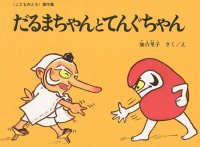Daruma as a Malevolent SpiritGoryou, Goryo = Malevolent spirit, avenging spirit, vengeful spirit, angry spirit. Since at least the Heian period, the Japanese have gone to great lengths to appease the spirits of those wrongfully killed or to correct an injustice they suffered -- otherwise, those spirits would return to wreak havoc on the living. The most famous case is that of Sugawara no Michizane (+845 - 903 AD), a courtier in the Heian period. Michizane was deified after death, for his demise was followed shortly by a plague in Kyoto, said to be his revenge for being exiled. Daruma's wrongful death (he was poisoned) gave him the aura of a vengeful spirit. Interestingly enough, Prince Shotoku Taishi himself, who is connected with Daruma via the legend of the
Kataoka beggar, died under suspicious circumstances as well, followed two months later by the death of his wife, and a few years later by the death of his son, who was forced to commit suicide by the Soga clan leader, thereby ending Shotoku's direct family line. Shotoku has thus been portrayed as an angry spirit.
Says
Bernard Faure: Daruma at the Crossroad. We have seen how the figure of Bodhidharma inserted itself into the legend of Shotoku Taishi through the intermediary of the
Kataoka beggar. According to Hartmut Rotermund, Shotoku Taishi's gift of a poem was perhaps aimed at revivifying the vital spirits (tama) of the starving man. Shotoku Taishi also allegedly gave his coat to the beggar. This act, which calls to mind St Martin's gift, has given rise to all kinds of interpretations into which I cannot enter here. Rotermund notes that cloth offerings were made in places deemed dangerous, such as crossroads and passes, and he suggests that we may be dealing here with an act destined to placate the dead. [Rotermund, 1998: 19-20]
According to Michael Como, this episode of Shotoku's legend may have been intended to co-opt preexisting rites of purification at the crossroad (chimata). At the intersection of roads connecting Naniwa with the Asuka region, where the court was located at the time, Kataoka was an important ritual space. Scholars have often argued that the Shotoku Taishi cult itself may have intended to placate the vengeful spirit of the Regent, whose entire family had been decimated by his political opponents. However, Shotoku himself was by no means an innocent ruler, and it is plausible that he took preexisting purification rites at Kataoka, in order to placate the vengeful spirits of his defeated enemies -- like Mononobe no Moriya. Kataoka was a site where rituals of spirit quelling were regularly undertaken by the Yamato court. These purification rites, center upon the fire god (a red deity), were designed to purify the land by sending evil spirits to the Ne no kuni. They involved the use of ritual dolls (hitogata), substitute bodies that were dressed in the ruler's clothes before being sent off, like scapegoats, bearers of collective defilement. In this contex, Shotoku Taishi's offering of his robe to the beggar on the roadside is no longer a sublime act of charity, it is a rite of purification and and of world renewal, connected to the New Year ritual. If Bodhidharma was perceived as a victim of untimely death, a potentially dangerous "foreign" spirit or god, it is not surprising that, after various symbolic drifts, it came to be identified with the Kataoka beggar, a threatening figure who had to be propitiated.
The fact that the Kataoka rituals were performed at a crossroad connects them to those of the crossroad deities (dosojin). As we have seen, these gods, also called sae no kami ("road-blocking deities"), were believed to protect villages and towns against calamities such as epidemics, insects, drought. Often represented by a man and a woman, engaged in implicit or explicit sexual behavior, they passed to ensure fecundity in women and sexual potency in men. We recall they were sometimes "personalized" as Ame no Uzume (Okame) and Sarutahiko. We find again Okame, in the Edo period, in the role of "Mrs. Daruma." Thus, one can think that Bodhidharma, once identified with the Kataoka beggar -- a crossroad deity -- became in turn a doosojin, and in some contexts displaced Sarutahiko as partner of Uzume. It is no wonder that Daruma dolls became symbols of sexuality and fecundity, and in particular of easy childbirth. <end Faure quote>
Faure also suggests there might be some association as well with the Tengu, a class of demonic beings populated by fallen monks who have misused their power, or by pious monks who vow to avenge some wrong. These beings are depicted with a long phallic nose. See
Tengu page for details.

Daruma playing "ken" (paper, rock, scissors) with a Tengu. The Tengu is a type of GORYO, or vengeful spirit.
Photo this J-book.